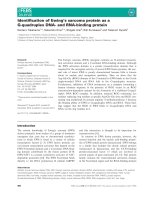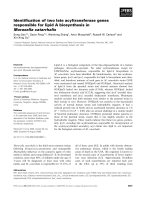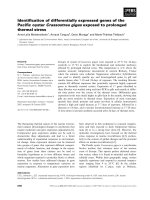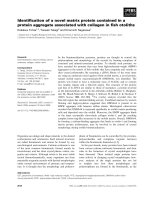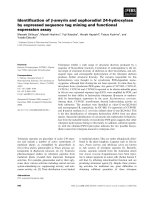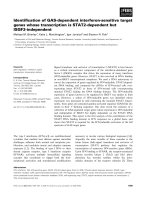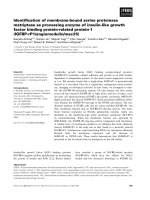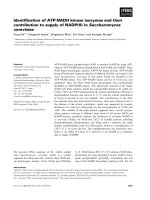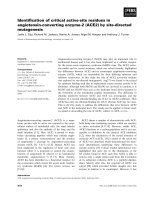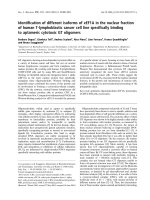Báo cáo khoa học: Identification of a copper-repressible C-type heme protein of Methylococcus capsulatus (Bath) A member of a novel group of the bacterial di-heme cytochrome c peroxidase family of proteins docx
Bạn đang xem bản rút gọn của tài liệu. Xem và tải ngay bản đầy đủ của tài liệu tại đây (846.55 KB, 12 trang )
Identification of a copper-repressible C-type heme protein
of Methylococcus capsulatus (Bath)
A member of a novel group of the bacterial di-heme
cytochrome c peroxidase family of proteins
Odd A. Karlsen
1
, Louise Kindingstad
1
, Solveig M. Angelska
˚
r
1
, Live J. Bruseth
1
, Daniel Straume
1
,
Pa
˚
l Puntervoll
2
, Anne Fjellbirkeland
1
, Johan R. Lillehaug
1
and Harald B. Jensen
1
1 Department of Molecular Biology, University of Bergen, Norway
2 Computational Biology Unit, Bergen Centre for Computational Science, Norway
Copper plays a very significant role in the physiology
of the methanotrophic bacterium Methylococcus capsul-
atus (Bath). The availability of this metal ion regulates
expression of the two forms of the methane-oxidizing
enzyme methane monooxygenase (MMO) the bacter-
ium possesses and formation of an extensive intracyto-
plasmic membrane network [1–4]. When copper is
scarce, at a low copper-to-biomass ratio, a soluble cyto-
plasmic MMO (sMMO) is responsible for the oxidation
of methane. At high copper-to-biomass ratios the parti-
culate MMO (pMMO) is expressed and there is no
detectable sMMO expression. Furthermore, copper
also influences the expression of at least two of the four
M. capsulatus formaldehyde dehydrogenases [5–7].
Keywords
cell surface exposed; copper regulated;
cytochrome c peroxidase; methanotrophs;
Methylococcus capsulatus
Correspondence
O. A. Karlsen, Department of Molecular
Biology, University of Bergen, HIB,
Thormøhlensgt. 55, 5020 Bergen, Norway
Fax: +47 555 89683
Tel: +47 555 84372
E-mail:
(Received 27 July 2005, revised 7 October
2005, accepted 17 October 2005)
doi:10.1111/j.1742-4658.2005.05020.x
Genomic sequencing of the methanotrophic bacterium, Methylococcus cap-
sulatus (Bath), revealed an open reading frame ( MCA2590 ) immediately
upstream of the previously described mopE gene (MCA2589). Sequence
analyses of the deduced amino acid sequence demonstrated that the
MCA2590-encoded protein shared significant, but restricted, sequence simi-
larity to the bacterial di-heme cytochrome c peroxidase (BCCP) family of
proteins. Two putative C-type heme-binding motifs were predicted, and
confirmed by positive heme staining. Immunospecific recognition and bioti-
nylation of whole cells combined with MS analyses confirmed expression
of MCA2590 in M. capsulatus as a protein noncovalently associated with
the cellular surface of the bacterium exposed to the cell exterior. Similar to
MopE, expression of MCA2590 is regulated by the bioavailability of cop-
per and is most abundant in M. capsulatus cultures grown under low cop-
per conditions, thus indicating an important physiological role under these
growth conditions. MCA2590 is distinguished from previously character-
ized members of the BCCP family by containing a much longer primary
sequence that generates an increased distance between the two heme-bind-
ing motifs in its primary sequence. Furthermore, the surface localization of
MCA2590 is in contrast to the periplasmic location of the reported BCCP
members. Based on our experimental and bioinformatical analyses, we
suggest that MCA2590 is a member of a novel group of bacterial di-heme
cytochrome c peroxidases not previously characterized.
Abbreviations
BCCP, bacterial cytochrome c peroxidase; CCP, cytochrome c peroxidase; ECL, enhanced chemiluminescence; MADH, methylamine
dehydrogenase; MALDI, matrix-assisted laser desorption ionization; MauG, methylamine-utilizing protein G; MeDH, methanol
dehydrogenase; MMO, methane monooxygenase; Mop, M. capsulatus outer membrane protein; NMS, nitrate mineral salt; ORF, open
reading frame; pMMO, particulate methane monooxygenase; SACCP, surface-associated cytochrome c peroxidase; sMMO, soluble
methane monooxygenase.
6324 FEBS Journal 272 (2005) 6324–6335 ª 2005 The Authors Journal compilation ª 2005 FEBS
We have previously described the surface-associated
protein, MopE, from which an N-terminally truncated
form, MopE*, is released into the culture medium
[8,9]. Furthermore, it was recently shown that MopE
responds to changes in copper concentration during
growth, and was most abundant when copper was lim-
ited, indicating an important physiological role at low
copper-to-biomass ratios [10]. Genomic sequencing of
M. capsulatus revealed an open reading frame (ORF,
denoted MCA2590) immediately upstream of the mopE
gene [11]. In this study, we show that the MCA2590-
encoded protein is expressed by M. capsulatus, and,
similarly to MopE, is located on the cellular surface of
the bacterium. Furthermore, expression of MCA2590
also responded to the availability of copper, and was
abundant when copper was scarce in the growth med-
ium. The MCA2590 primary sequence shares signifi-
cant but restricted sequence similarity to the bacterial
di-heme cytochrome c peroxidase (BCCP) family of
proteins and contains two conserved heme-binding
motifs. We also demonstrate that the MCA2590 pro-
tein contains C-type heme; this was in line with our
predictions from the primary sequence. Extensive bio-
informatical analyses suggest that MCA2590 is a
member of a novel group of the BCCP family.
Results
Sequence analyses
An ORF of 2322 nucleotides (MCA2590) was predic-
ted upstream and in the same orientation as mopE
in the M. capsulatus genome (Fig. 1A) [11]. Twenty-six
nucleotides separated the predicted stop codon for the
putative protein MCA2590 and the translation start
site of MopE. Sequence analyses including the
MCA2590, mopE and upstream nucleotides of
MCA2590, revealed a candidate promoter region 5¢ of
the potential start codon of the putative MCA2590
protein (Fig. 1B). In addition, a transcription termin-
ation site consisting of a GC-rich palindrome sequence
followed by an AT-dominant stretch of nucleotides
was found downstream of the mopE gene [9]. The lack
of significant predictions of promoter and terminator
regions immediate 5¢ of mopE indicates an MCA2590⁄
mopE operon. Furthermore, two putative ribosomal
binding sites could be predicted upstream of both the
MCA2590 and the mopE gene (Fig. 1). Our attempts
to detect transcripts overlapping the MCA2590 ⁄ mopE
transition have so far been unsuccessful.
The putative MCA2590-encoded protein consists of
773 amino acids (Fig. 1B). Bioinformatical analyses
using signalp and psort predicted a leader peptide
with a putative cleavage site between Ala41 and His42
(Fig. 1B). N-Terminal processing would lead to a
mature protein of 732 amino acids with a theoretical
molecular mass of 78 kDa. A search in the PROSITE
database of protein families and domains [12] with
MCA2590 revealed two regions matching the c-type
cytochrome superfamily profiles (PS51007). Both
regions contain the c-type cytochrome motif (CxxCH;
Fig. 1B), suggesting that MCA2590 binds two hemes.
Sequence similarity searches (BLASTp) revealed signi-
ficant similarity to hypothetical proteins of Photobacte-
rium profundum (UniProt: Q6LQ47), Pseudomonas
fluorescens (GenBank: ZP_00262397.1), and Nostoc
punctiforme (GenBank: ZP_00109402.2), with expect
(E)-values of 1e
)116
,1e
)98
and 1e
)69
, respectively.
However, neither confirmation of expression nor any
functions have been assigned to these putative pro-
teins. Also proteins with known functions were
revealed in the BLASTp searches, e.g. the cyto-
chrome c peroxidase (CCP) of Nitrosomonas europaea
(UniProt: P55929, E ¼ 4e
)5
) and the methylamine util-
ization protein MauG of Paracoccus denitrificans
(UniProt: Q51658, E ¼ 4e
)4
). Both these proteins are
members of the BCCP family of proteins [13] (pfam
03150), but are representatives of two functionally dis-
tinct subsets of the BCCP family [14]. To further
explore the relationship between MCA2590 and the
CCP and MauG proteins, members of each group
were collected by performing several BLASTp searches
(see Experimental procedures). Pairwise comparisons
revealed that the hypothetical MCA2590-related
sequences from P. profundum, P. fluorescens and
N. punctiforme are 40–44% identical to the MCA2590,
in contrast to the CCP and MauG sequences that
are < 30% identical. A multiple sequence alignment
including the hypothetical MCA2590-related sequences,
and the CCP and MauG sequences, was constructed
(alignment of representative members from each group
of sequences are shown in Fig. 2). Figure 2 shows
that there are conserved segments throughout the
alignment and that these segments coincide well with
secondary structure elements obtained from the
resolved structures of the Pseudomonas aeruginosa and
N. europaea CCPs. Strikingly, residues of both the
heme-binding sites (CxxCH), in addition to the amino
acids coordinating the calcium ion present in the
interface domain of the solved CCPs are positionally
conserved in MCA2590. It is also evident that the
MCA2590 and the hypothetical MCA2590-related
sequences, owing to the near double length, introduce
large gaps in the CCP and MauG sequences when
sequence similarities are aligned. Importantly, almost
all of these gaps were introduced between secondary
O. A. Karlsen et al. Heme protein identification in M. capsulatus
FEBS Journal 272 (2005) 6324–6335 ª 2005 The Authors Journal compilation ª 2005 FEBS 6325
structure elements, leaving b sheets and a-helical struc-
tures intact. It is also interesting to notice that
MCA2590 and the hypothetical MCA2590-like
sequences share significant sequence similarity in some
of the long segments that remained unaligned to the
CCPs and MauGs, indicating a common secondary
structure ⁄ fold for the hypothetical MCA2590-related
sequences in these regions. To examine the similarity
between the MCA2590 and the BCCP sequences more
closely, the multiple sequence alignment (Fig. 2) was
visualized in the context of the N. europaea CCP struc-
ture (Fig. 3). This analysis showed that positions that
are identical or display a high degree of similarity
between the MCA2590 and the CCP sequences are
located in the core of the CCP structure (Fig. 3A).
Furthermore, all of the additional insertions of the
extended MCA2590 sequence are introduced in loop
regions on the surface of the structure, thereby not
interrupting secondary structure elements in the
N. europaea CCP (Fig. 3B). The MCA2590 insertions
were mainly dispersed around the entire surface. Taken
together, these observations strongly suggest that
the MCA2590 and hypothetical MCA2590-related
sequences are homologous to the BCCP family of pro-
teins, and form a separate group with a similar fold
and core structure. However, the members of this new
A
MCA2590 mopE
B
Fig. 1. Genomic orientation (A), nucleotide
and amino acid sequence (B) of MCA2590.
(A) MCA2590 is oriented in the M. capsula-
tus genome immediate upstream of the
mopE gene separated by 26 nucleotides. (B)
Amino acids are indicated below the nucleo-
tide sequence. The underlined promoter
region was predicted using the Neural Net-
work Promoter Prediction (NNPP) and was
estimated to have a probability of 0.97. The
previously predicted termination loop is indi-
cated by black arrows [9]. The two putative
ribosomal binding sites predicted upstream
of MCA2590 and mopE, respectively, are
enlarged in the nucleotide sequence. The
signal peptide predicted by
SIGNALP is col-
oured red in the MCA2590 amino acid
sequence. The two putative C-type heme-
binding sites revealed by
SCANPROSITE are
shown in yellow. The amino acid sequence
used for construction of the anti-MCA2590
serum is blue. The peptides of MCA2590
that were revealed in the MALDI MS ⁄ MS
analysis (Table 1) are boxed.
Heme protein identification in M. capsulatus O. A. Karlsen et al.
6326 FEBS Journal 272 (2005) 6324–6335 ª 2005 The Authors Journal compilation ª 2005 FEBS
Fig. 2. Multiple sequence alignment of MCA2590 and selected members of the BCCP family of proteins. The alignment was constructed from five MCA2590-like sequences, 26 CCP
sequences and seven MauG sequences as identified in BLASTp searches (see Experimental procedures for details). Secondary structures obtained from the resolved structures of the
CCP proteins from N. europaea (CCP_Ne; PDB:1IQC) and P. aeruginosa (CCP_Pa; PDB:1EB7) are indicated above the alignment (a, a helix; b , b strand; g,3
10
-helix; T: turn). Only the region
of the alignment fully covered by the N. europaea CCP sequence is shown. The four cysteine residues that covalently bind two hemes and the two histidines that functions as heme–iron
ligands are marked with triangles. The calcium ligand residues are indicated with circles. Only selected members of CCPs and MauGs are shown (accession numbers are given: GB, Gen-
Bank; UP, UniProt). CCP members (group 1): CCP_Ne: N. europaea (UniProt: P55929); CCP_Pa: P. aeruginosa (UniProt: P14532); Q60BW8_Mc: M. capsulatus (UniProt: Q60BW8). MauG
members (group 2): MauG_Pd: P. denitrificans (UniProt: Q51658); MauG_Mf: M. flagellatum (UniProt: Q50426); MauG_Mm: M. methylotrophus (UniProt: Q50233); M. extorquens (UniProt:
Q49128). Hypothetical MCA2590-like sequences (group 3): 109402_Np: N. punctiforme (GenBank: ZP_00109402); Q6LQ47_Pp: P. profundum (UniProt: Q6LQ47); 262397_Pf: P. fluores-
cens (GenBank: ZP_00262397); MCA2590_Mc: M. capsulatus (UniProt: Q6LQ47); U74385_Ma: M. album (GB:U74385 – fragment: missing N- and C-termini are marked with *). Visualiza-
tion was made using
ESPRIPT: Positions that are identical between all groups are marked with black boxes and similar positions are marked with white boxes. Positions that are similar or
identical within one group are shown in bold. The annotation is based on the full alignment.
O. A. Karlsen et al. Heme protein identification in M. capsulatus
FEBS Journal 272 (2005) 6324–6335 ª 2005 The Authors Journal compilation ª 2005 FEBS 6327
group will contain longer loops and possibly additional
secondary structure elements outside the CCP-similar
core.
A similarity search against the translated GenBank
nucleotide database (tBLASTn) revealed significant
similarity between MCA2590 and an unannotated
ORF of Methylomicrobium album (GenBank: U74385 –
nucleotides 3279–4205; E-value 1e
)67
) [15]. Interest-
ingly, this ORF is located immediately downstream of
the corA gene, which encodes the only protein in the
databases that shows significant sequence similarity to
MopE [9,15]. The deduced amino acid sequence of the
M. album U74385 ORF was added to the multiple
sequence alignment (Fig. 2), revealing that it is 50%
identical to the N-terminal half of the MCA2590 pro-
tein. Because the fully sequenced U74385 ORF is not
available in the databases, it remains to be elucidated
if the sequence similarity of MCA2590 and the
M. album U74385 ORF extends even further.
Localization and identification of the mature
MCA2590 protein
Enriched fractions of M. capsulatus-soluble proteins,
inner membrane proteins and outer membrane proteins
were obtained as described previously [8]. The resulting
fractions were assessed by SDS⁄ PAGE, demonstrating
the presence of the large subunit of the methanol dehy-
drogenase (MeDH) in the soluble fraction and the
outer membrane proteins MopB and MopE in the
A
B
Fig. 4. SDS ⁄ PAGE (A) and protein immunoblot analyses (B) of pro-
teins obtained during the fractionation of M. capsulatus. Samples
of each step during the fractionation procedure were collected and
comparable samples (10 lL of each 1 mL fraction) were analysed.
(A) Coomassie Brilliant Blue (CBB) R-250 stained 10% polyacryl-
amide gel. (A, B) Lane 1, whole cells (W); lane 2, soluble fraction
(S); lane 3, total membrane fraction (TM); lane 4, Triton X-100
soluble membranes (enriched inner membrane fraction, IM); lane 5,
Triton X-100 insoluble membranes (enriched outer membrane
fraction, OM). MopE in addition to the OmpA related MopB [38]
are indicated. (B) Protein immunoblot of (A) using the anti-
MCA2590 serum. Molecular mass markers are indicated to the left
of both subfigures.
Fig. 3. The sequence similarity between MCA2590 and the CCP proteins visualized on the N. europaea CCP structure. Bound ligands are
shown in green; the heme groups are shown as sticks, and the Ca
2+
ion is shown as a sphere. (A) The surface of the structure is shown in
transparent white. Residues that are identical between the MCA2590 and CCP sequences in the alignment are shown in red, and similar
residues are shown from yellow to red with increasing similarity. (B) A cartoon representation of the structure. Positions in the structure
where gaps were introduced in the alignment are marked with blue spheres. The N- and C-termini are marked.
Heme protein identification in M. capsulatus O. A. Karlsen et al.
6328 FEBS Journal 272 (2005) 6324–6335 ª 2005 The Authors Journal compilation ª 2005 FEBS
Triton X-100 insoluble fraction (enriched outer mem-
brane fraction) (Fig. 4A). When protein immunoblots
of the enriched fractions were probed with a constructed
antibody to a short peptide derived from the MCA2590
sequence, an anti-MCA2590 immunoreactive polypep-
tide was found to cofractionate with the outer mem-
brane from cells grown at a low copper-to-biomass ratio
(Fig. 4B). The polypeptide migrated with a relative
molecular mass of 80 kDa, which is close to the mass
predicted for the mature MCA2590 (78 kDa).
To further establish the cellular localization of
MCA2590, M. capsulatus whole cells were treated with
a high ionic strength buffer to extract proteins associ-
ated with the cell surface. Treatment of whole cells
with high concentrations of NaCl disrupts electro-
static ⁄ ionic bonds between biomembranes and pro-
teins, thus leaving surface-associated polypeptides in
the resulting supernatant upon centrifugation [16,17].
The NaCl extraction was performed in two steps
with increasing NaCl concentrations. Analyses of the
resulting fractions by SDS ⁄ PAGE displayed a complex
crude cell-extract protein pattern in the untreated cells
and in cells treated with 0.5 and 1 m NaCl (Fig. 5A,
lanes 1, 4 and 6). Importantly, the large 60 kDa sub-
unit of the MeDH was seen only in these fractions.
MeDH is a periplasmic protein [18], hence indicating
that the cells remained undisrupted during the extrac-
tion procedure and thereby avoiding leakage of pro-
teins from the periplasm. Protein immunoblot using
antibodies raised against MCA2590 revealed this
protein in the 0.5 m NaCl-extracted fraction (Fig. 5B,
lane 3). This observation suggests a specific association
of MCA2590 to the outer membrane and that it is
exposed to the cell exterior. As expected and in line
with previous reports, a similar extraction behavior
was observed for MopE [9] (Fig. 5B). The integral
outer membrane OmpA-related MopB protein was not
extracted from the outer membrane by the NaCl treat-
ment, demonstrating the selectivity of the extraction
procedure (Fig. 5B).
To ensure that the localization of MCA2590 is at
the external surface and not at the periplasmic inter-
face, we performed two additional experiments.
M. capsulatus whole cells were immobilized on a nitro-
cellulose membrane and treated with the anti-
MCA2590 serum (Fig. 6A). The MCA2590-specific
staining obtained is consistent with SACCP being sur-
face exposed. As another demonstration of surface
exposure, we labelled intact cells grown in flask cul-
tures with biotin (Fig. 6B). Biotin is too large to penet-
rate the outer membrane and will only label
polypeptides that have a lysine-containing sequence
accessible at the cell surface. The biotinylated cells
AC
B
Fig. 5. SDS ⁄ PAGE and protein immunoblot analyses of protein frac-
tions obtained during the NaCl extraction of surface proteins. (A)
10% polyacrylamide gel stained with CBB R-250. The periplasmic
methanol dehydrogenase (MeDH) and the surface associated MopE
are indicated. (A, B) Lane 1, cells resuspended in 5 mL buffer with
low ionic strength (20 m
M Tris ⁄ HCl) (10 lL sample applied); lane 2,
20 m
M Tris ⁄ HCl wash (20 lL sample applied); lane 3, 0.5 M NaCl
extract (20 lL sample applied); lane 4, whole cells treated with
0.5
M NaCl (10 lL sample applied); lane 5, 1 M NaCl extract (20 lL
sample applied); lane 6, whole cells treated with 1
M NaCl (10 lL
sample applied). (B) Protein immunoblots of (A) using anti-
MCA2590, anti-MopE and anti-MopB sera, respectively. Molecular
mass markers are indicated to the left of (A) and (B). (C) Concentra-
ted (selective centrifugation, Amicon 10 kDa cut-off) 0.5
M NaCl
extracted fraction separated by SDS ⁄ PAGE and stained with CBB
R-250. The polypeptide migrating with a corresponding molecular
mass to the anti-MCA2590 immunogenic band is indicated.
A
B
Fig. 6. Dot-blot and biotinylation analyses of whole cells. (A) Dot-
blot analyses of M. capsulatus cells (0.5 · 10
8
) immobilized onto
nitrocellulose membranes. (1) Cells treated with the anti-MCA2590
serum. (2) Negative control; cells treated exclusively with secon-
dary HRP-conjugated antibody. (B) Protein immunoblott of biotin-
labelled M. capsulatus cells. (1) Biotin-labelled proteins visualized
by treatment with streptavidine biotinylated HRP complex. (2) The
same protein immunoblot as (1) but treated with the anti-MCA2590
serum.
O. A. Karlsen et al. Heme protein identification in M. capsulatus
FEBS Journal 272 (2005) 6324–6335 ª 2005 The Authors Journal compilation ª 2005 FEBS 6329
were analyzed with protein immunoblotting using the
anti-MCA2590 serum, followed by removal of bound
antibodies and staining of all biotinylated proteins
using streptavidin-biotinylated horseradish peroxidase
complex on the very same membrane. By using mark-
ers on the nitrocellulose membrane we observed an
exact comigration of a biotinylated protein with the
immunoreactive MCA2590 band, strongly suggesting
that MCA2590 has been biotinylated. The major peri-
plasmic protein, MeDH, was not labelled by biotin,
demonstrating that only surface-exposed proteins were
labelled during the procedure.
A 0.5 m NaCl-extracted fraction of M. capsulatus
whole cells was concentrated by selective centrifugation
(Amicon, 10 kDa cut-off) and the polypeptide migra-
ting with an apparent molecular mass of 80 kDa in the
SDS ⁄ PAGE analysis of the concentrate was excised
from the gel and subjected to MS analyses (Fig. 5C).
MALDI MS ⁄ MS analyses revealed three sequenced
peptides (Table 1), which identified the excised poly-
peptide as the gene product of MCA2590. Based on
these findings and our bioinformatical analyses, we
have named the MCA2590-encoded protein-surface-
associated cytochrome c peroxidase (SACCP).
Expression
The expression of MopE is influenced by the avail-
ability of copper [10]. Thus, it was of great interest
to explore if MCA2590 and mopE were concomit-
antly expressed if organized in a single transcrip-
tional unit. M. capsulatus was grown at high and
low copper-to-biomass ratios in batch cultures (0, 0.8
and 5 lm copper included in the growth medium)
and expression was analysed by protein immunoblots
using the anti-MCA2590 serum (Fig. 7). The subunits
of pMMO (Fig. 7A), as well as detection of sMMO
activity [19], were used as markers for copper-to-bio-
mass ratios in M. capsulatus cultures. The protein
immunoblots revealed that the expression of SACCP
was altered by the different copper concentrations,
SACCP being most strongly expressed in cells grown
in low copper media (Fig. 7B). Specific PCR prim-
ers were designed for MCA2590, and differential
expression in cells cultured under high- or low-
copper conditions was verified by RT-PCR analyses
(Fig. 7C).
Detection of C-type heme
Because of the sequence similarity of SACCP to mem-
bers of the BCCP family of proteins and the predic-
tion of heme-binding motifs in the primary sequence,
it was of interest to assay for the presence of C-type
heme in SACCP. However, because our SACCP pre-
paration contains other proteins that may also express
C-type heme-specific peroxidase activity, we designed
an assay that would distinguish SACCP from other
proteins with similar activity. NaCl-extracted proteins
separated by SDS ⁄ PAGE were transferred to a nitro-
cellulose membrane and directly stained for heme
using enhanced chemiluminescence (ECL). This
method takes advantage of the intrinsic peroxidase
activity of the covalently bound heme group of dena-
tured c-type cytochromes, and should, in principle,
detect any hemeprotein that retains heme after such
treatment as described above [20,21]. The activity
measurement of the NaCl extract resulted in four
Table 1. MALDI MS ⁄ MS analyses of anti-MCA2590 immunogenic
band. The localization of the identified peptides in the MCA2590
amino acid sequence is shown in Fig. 1.
m ⁄ z (measured) Peptide sequence
1453.80 NTPTVINAALFHR
1593.80 VRDEAAPFDHPALR
2348.10 SVSDADGDGLADDEFLEIPAVGR
A
B
C
Fig. 7. Copper regulation analyses of MCA2590 (SACCP). (A)
SDS ⁄ PAGE analyses of M. capsulatus cells grown at 5 (lane 1), 0.8
(lane 2), and 0 l
M copper included in the growth medium,
respectively. The 10% polyacrylamide gel was stained with CBB
R-250. The PmoA, PmoB and PmoC components of the particulate
methane monooxygenase are indicated (observed in lane 1 and 2).
sMMO activity in the cell cultures are shown by either (+) or (–)
below the lanes. (B) Protein immunoblot of (A) using anti-MCA2590
and anti-MopE serum, respectively. Molecular mass markers are
indicated to the left of both (A) and (B). (C) RT-PCR analyses of the
MCA2590, mopE and mopB transcripts prepared from the same
cultures as used in (A) and (B).
Heme protein identification in M. capsulatus O. A. Karlsen et al.
6330 FEBS Journal 272 (2005) 6324–6335 ª 2005 The Authors Journal compilation ª 2005 FEBS
distinct bands, all of which could be traced to corres-
ponding bands on a parallel CBB-stained polyacryl-
amide gel (Fig. 8). Most importantly, a distinct band
of molecular mass corresponding to the migration of
SACCP was identified, suggesting that SACCP
contained bound heme. A protein immunoblot using
antibodies directed against SACCP on the same nitro-
cellulose membrane showed that the peroxidase-activ-
ity-stained band and the SACCP immunogenic band
colocalized (Fig. 8). Using MS, The two additional
high molecular mass bands, which also stained positive
for heme, were identified as the proteins encoded by
the genes MCA0421 and MCA0423, annotated as a
cytochrome c
553o
family protein and cytochrome c
553o
,
respectively (data not shown) [11,22].
Discussion
In this study, we show that the predicted ORF
(MCA2590) upstream of the mopE gene in M. capsula-
tus encodes a C-type heme protein (SACCP) whose
expression is strongly increased in bacteria cultured at
low-copper concentrations. The protein is located on
the surface of the bacterium and is noncovalently
attached to the outer membrane. The extracellular
localization is in accordance with the prediction of a
signal peptide in a primary translation product.
Bioinformatical analyses revealed that SACCP
shares characteristics with previously described mem-
bers of the BCCP family of proteins by both having
significant sequence similarity and containing two con-
served C-type heme-binding motifs [13]. This family
constitutes the bacterial di-heme cytochrome c peroxid-
ases. Similar to other CCPs, they reduce hydrogen per-
oxide to water using C-type heme as cofactor. The
BCCP family also includes the MauG proteins, whose
similarity to di-heme CCPs has previously been recog-
nized [23,24]. However, the MauG subset is distinct
from the CCPs, and MauGs are proposed to function
in the oxidation of methylamine in facultative methylo-
trophs [23,24]. Importantly, SACCP significantly differ
from the BCCP family of proteins in its much longer
amino acid sequence. The regions of similarities to the
CCPs and MauGs are therefore restricted, and in mul-
tiple alignments distributed as conserved segments
throughout the SACCP amino acid sequence. As in
the BCCPs, two putative heme-binding motifs were
found conserved N- and C-terminally of the SACCP
sequence, indicating the binding of heme-groups anal-
ogous to the low- and high-potential heme present in
both CCPs and in the MauG proteins. Furthermore,
the regions in SACCP with highest sequence similarity
to the BCCP family of proteins coincided nicely with
the known secondary structure elements of both the
P. aeruginosa and N. europaea CCPs [25], indicating a
native fold of SACCP which resembles the structure of
CCPs. This supposition was substantially supported
by structural visualization of the multiple alignments
between the SACCP sequence and its close homo-
logues, and the BCCP sequences (Fig. 3). These analy-
ses showed that the additional SACCP-specific amino
acid sequences were all located on the protein surface,
and in-loop regions not interrupting secondary struc-
ture elements. Furthermore, the majority of the con-
served residues were buried amino acids, thereby
maintaining the structural integrity of an N. europaea
CCP-similar fold of SACCP, and thus bringing the
hemes in close proximity to each other in contrast to
increased interheme distance found in the primary
sequence. We also showed that SACCP stained posit-
ively for peroxidase activity typical of the covalently
bound heme groups of denatured c-type cytochromes
[20,21]. The C-type heme-associated peroxidase activity
is in accordance with the presence of heme-binding
motifs in the primary sequence. Interestingly, in the
course of this study, two other surface-associated
proteins that also stained positive for C-type heme
were identified. Both of these proteins have previously
been described as multi-c-heme cytochromes (cyto-
chrome c
553o
and cytochrome c
553o
family protein) of
M. capsulatus, and the respective genes are clustered in
the genome [11,22]. We have now provided novel evi-
dence for these proteins being noncovalently attached
to the cellular surface. It is interesting to notice that 57
putative c-type cytochrome proteins are annotated in
the M. capsulatus genome, of which five are members
AB C
Fig. 8. Detection of C-type heme in MCA2590 (SACCP). (A–C) Lane
1, 0.5
M NaCl extract from M. capsulatus; lane 2, bovine serum
albumin. (A) 10% CBB R-250 stained polyacrylamide gel obtained
from SDS ⁄ PAGE analysis. (B) Samples corresponding to (A) trans-
ferred to a nitrocellulose membrane and directly stained for C-type
heme peroxidase activity. (C) Protein immunoblot of a membrane
corresponding to (A) using the anti-MCA2590 serum. Molecular
mass markers are indicated to the left of (A).
O. A. Karlsen et al. Heme protein identification in M. capsulatus
FEBS Journal 272 (2005) 6324–6335 ª 2005 The Authors Journal compilation ª 2005 FEBS 6331
of the cytochrome c
553o
family and four are annotated
as putative cytochrome c peroxidases [11]. In this
study, three of these have been localized to the cellular
surface.
As shown previously for MopE [10], the expression
of SACCP was found regulated by the copper concen-
tration in the growth medium and was found most
abundant in cells grown in copper-depleted medium.
RT-PCR analyses revealed that this regulation takes
place at the transcriptional level. The concomitant
regulation of SACCP and MopE is also in accordance
with the possibility that the MCA2590 and mopE genes
constitute an operon, but evidence of this assumption
has not yet been provided. Furthermore, a potential
promoter was predicted with high significance both by
BPROM and NNPP immediate 5¢ of MCA2590. Very
interestingly, the following nucleotide sequence was
identified within the predicted promoter region:
5¢-TTGAGN(5)ATCGA-3¢. This nucleotide sequence
closely resembles the consensus binding site of the
transcriptional factor Fnr, 5¢-TTGATN(4)ATCAA-3¢,
introducing only two mismatched nucleotides. FNR-
type regulators are known to regulate aerobic ⁄ anaer-
obic-dependent gene expression in c-proteobacteria,
and the gene product of the fnrA gene in Pseudomonas
stutzeri controls the expression of cythochrome cbb
3
-
type terminal oxidase, cytochrome c peroxidase and
the oxygen-independent coproporphyrinogen III
oxidase [26]. M. capsulatus harbours one copy of a
Fnr-type transcriptional regulator (MCA2120) [11].
However, further studies are necessary to elucidate the
regulatory mechanisms for MCA2590 and mopE.
The biological function of SACCP remains to be
elucidated. However, upregulation of SACCP in
M. capsulatus when grown at a low copper-to-biomass
ratio indicates an important physiological role under
these growth conditions. Furthermore, the concomitant
expression, in addition to both the genomic and cellu-
lar colocalization, of SACCP and MopE, indicates that
these proteins may cooperate and have linked func-
tions. In general, CCPs are thought to play a protect-
ive role in the periplasm by reducing peroxides
generated in oxidative metabolism [27]. MauG seems
to have a more specific function, as demonstrated in
P. denitrificans, by being involved in the maturation of
the tryptophan tryptophylquinone cofactor of methyl-
amine dehydrogenase (MADH) [14,28]. This enzyme is
responsible for the oxidative deamination of methyl-
amine when facultative methylotrophs are grown on
methylamine as the sole source for carbon and energy
[24]. The strong indications of SACCP having a core
structure that resembles the CCPs may point toward
similar enzymatic mechanisms. However, the increased
size and cellular localization of SACCP open the possi-
bility of other physiological functions distinct from
what has been described for CCPs and MauGs.
In conclusion, we have described a novel C-type
heme protein located to the cellular surface of the
methanotrophic bacterium M. capsulatus. This protein
shares characteristics with the members of the BCCP
family, but separates itself from the described CCPs
and MauGs in both amino acid sequence and cellular
location. Significant sequence similarity to three hypo-
thetical proteins found in the prokaryotes P. profun-
dum, P. fluorescens and N. punctiforme, respectively,
was observed, in addition to a partial sequenced ORF
of the methanotroph, M. album. Based on the amino
acid sequence, experimental and bioinformatical data,
we propose that SACCP belongs to a novel class of
the bacterial di-heme cytochrome c peroxidases. Inter-
estingly, the M. album ORF was found in close prox-
imity to the CorA encoding gene (corA) which shares
sequence similarity to MopE of M. capsulatus.It
remains to be seen if this colocalization is a unique
feature of methanotrophs. However, the colocalization
may indicate a linked and unique function of these
proteins in bacteria possessing both genes.
Experimental procedures
Growth of Methylococcus capsulatus (Bath)
M. capsulatus NCIMB 11132 was grown in batch cultures
at 45 °C while shaking in an atmosphere of CH
4
,CO
2
, and
O
2
(45 : 10 : 45) in nitrate mineral salt (NMS) medium as
described previously [29]. Most analyses were performed
using cells grown at a low copper-to-biomass ratio in
‘copper-free’ medium (no copper added). The cultures were
screened for soluble methane monooxygenase (sMMO)
activity by the naphthalene assay described by Brusseau
et al. [19] to ensure that a low copper-to-biomass ratio was
achieved. When analysing differential expression of
MCA2590, cells grown at high copper-to-biomass ratios
were included in the experiment (0.8 and 5 l m copper in
the growth medium). Batch cultures of M. capsulatus were
grown to a cell density of 10
8
cellsÆmL
)1
before
harvesting.
Fractionation of cells
Cells were harvested by centrifugation at 5000 g for
10 min. Enriched fractions of the soluble proteins, inner
membrane proteins and outer membrane proteins were
obtained as described by Fjellbirkeland et al. [8]. 20 mm
Tris ⁄ HCl, 1 mm CaCl
2
, pH 7.4, was used as buffer
throughout the fractionation procedure.
Heme protein identification in M. capsulatus O. A. Karlsen et al.
6332 FEBS Journal 272 (2005) 6324–6335 ª 2005 The Authors Journal compilation ª 2005 FEBS
Extraction of cell-surface proteins
M. capsulatus cells were harvested by centrifugation at
5000 g for 10 min, and resuspended in a small volume of
20 mm Tris ⁄ HCl, 1 mm CaCl
2
, pH 7.4. The cell suspen-
sion was centrifuged (as described above), and the super-
natant was collected for SDS ⁄ PAGE analyses. Pelleted
cells were treated with Tris ⁄ HCl buffer of high ionic
strength (20 mm Tris ⁄ HCl, pH 7.4, 1 mm CaCl
2
, 0.5 m
NaCl) to disrupt noncovalent bonds between surface-asso-
ciated proteins and components of the outer membrane
[16,17]. Cells were incubated with rotation in this buffer
for 1–2 h at 4 °C. Cells were subsequently collected by
centrifugation, and the resulting supernatant contained
the 0.5 m NaCl-extracted proteins. Treated cells were re-
suspended in 20 mm Tris ⁄ HCl, 1 mm CaCl
2
,1m NaCl,
pH 7.4, thereby increasing the ionic strength of the
extraction buffer. Cells were thereafter incubated with
rotation and harvested as outlined above, resulting in the
1 m NaCl extracted protein fraction. Cells were resus-
pended in 20 mm Tris ⁄ HCl, 1 mm CaCl
2
, pH 7.4 after
centrifugation.
Biotinylation of cell-surface proteins
Biotinylation of whole cells was performed with EZ-Link
Sulfo-NHS-biotin according to the manufacturer’s instruc-
tions (Pierce, Rockford, IL). Biotinylated proteins were
visualized on nitrocellulose membranes by treatment with
streptavidin-biotinylated horseradish peroxidase complex as
described by the manufacturer (Amersham Biosciences,
Little Chalfont, UK).
SDS ⁄ PAGE and Western blotting
SDS ⁄ PAGE was performed as described by Laemmli et al.
[30] using 10% (w ⁄ v) running gels and 3% (w ⁄ v) stacking
gels. Protein immunoblotting was carried out as described
previously [8]. Rabbit polyclonal peptide-specific antibodies
against MCA2590 were produced by Sigma Genosys. The
immunogen correspond to the amino acids 742–755 of the
MCA2590 primary sequence (Fig. 1B). The specificity of
the produced antibody was confirmed by indirect ELISA.
Horseradish peroxidase-linked anti-rabbit sera were pur-
chased from Bio-Rad (Hercules, CA). Protein immunoblots
that were incubated with anti-MopE or anti-MopB sera
were developed using the colour reagent HRP CDR (Bio-
Rad). Anti-MCA2590-treated membranes were developed
using ECL (Amersham Biosciences).
Detection of C-type heme
Proteins separated by SDS ⁄ PAGE were transferred to a
nitrocellulose membrane by electroblotting and directly
stained for C-type heme with the ECL assay as described
previously [20,21]. The ECL reagent was supplied from
Amersham Biosciences.
MS identification of proteins
MS analyses were performed at the PROBE facility at the
University of Bergen, Norway.
Isolation of total RNA
M. capsulatus flask cultures were harvested by centrifugation
at 16 300 g for 1 min. Pellets were resuspended in
Tris ⁄ EDTA buffer (0.1 mm Tris ⁄ HCl, 0.1 mm EDTA,
pH 8.0) and submerged directly into liquid nitrogen and
stored at )80 °C until used. RNA isolation and DNase
treatment were carried out using the QIAGEN RNeasy
Mini Kit as described in the supplied ‘RNAprotect Bacteria
Reagent Handbook’ with an additional DNase treatment on
the column. The RNA was dissolved in 50 lL of RNase-free
water and the A
260
and A
280
values were determined. The
RNA quality and quantity was determined with the Agilent
2100 Bioanalyser and the 2100 expert software.
RT-PCR
First-strand synthesis was carried out with 1 lg of total
RNA. Superscript
TM
II RNase H
–
Reverse Transcriptase
(Invitrogen, Carlsbad, CA) was used for first strand synthe-
sis according to the manufacturer’s protocol. RNasin
(Promega, Madison, WI) was used in the mixture to inhibit
any RNAse activity. The cDNA synthesis was carried out
using an elongation gradient ranging from 35 to 55 °C,
where the temperature was raised 5 °C every 10 min. The
primers used in the synthesis were 40 oligomers calculated
to anneal to all ORFs in the M. capsulatus genome. The
primers were defined using the program ‘Genome directed
primers’ as described by Talaat et al. [31].
PCR was performed according to standard procedures
[32]. The reverse transcription reaction (1 lL) was subjec-
ted to PCR amplification using 1 U of DyNAzyme
TM
EXT
DNA Polymerase (Finnzymes), in a 25-lL reaction volume
with 0.2 mm dNTP, 0.5 lm of each specific primer, 1.5 mm
MgCl
2
5% dimethylsulfoxide and the appropriate buffer.
The ‘housekeeping’ genes encoding ribosome binding
protein B, rplB, and M. capsulatus outer membrane protein
B, mopB, were amplified. The amounts of PCR products
were determined using the Fuji FLA-2000 phosphoimager,
and the amount of template of first-strand cDNA was
corrected to give an equal amount of amplified PCR prod-
ucts for each ‘housekeeping’ gene. The differential expres-
sion of the sapE and mopE transcripts was determined
using the primers: sapE–F sapE–R and mopE–F mopE–R
(Table 2).
O. A. Karlsen et al. Heme protein identification in M. capsulatus
FEBS Journal 272 (2005) 6324–6335 ª 2005 The Authors Journal compilation ª 2005 FEBS 6333
Bioinformatic analyses
Sequence similarity searches were performed in the UniProt
( and GenBank (http://
www.ncbi.nlm.nih.gov/BLAST/) databases using BLASTp
or tBLASTn with default settings [33]. Thirty-five cyto-
chrome c peroxidase proteins were identified by collecting
sequences with an expect-value below 1e
)60
to query
sequences from N. europaea (UniProt: P55929) or P. aerugi-
nosa (UniProt: P14532). Nine of those sequences contained
an N-terminal extension with an additional CxxCH heme-
binding motif, and were subsequently removed from the
analysis. Seven MauG sequences were similarly collected by
performing BLASTp searches with query sequences from
P. denitrificans (UniProt: Q51658) and M. methylotrophus
(UniProt: Q50233). The multiple sequence alignment was
generated with clustalx (v. 1.83) using default alignment
parameters [34]. The multiple sequence alignment was sub-
jected to visualization and analysis in the context of avail-
able structures using the ESPript service [35]. Briefly,
similarity scores for each position in the alignment between
the four full-length MCA2590-like sequences and the 26
CCP sequences were calculated with ESPript using the
Risler matrix, and these scores were used to replace the B
factors of the N. europaea CCP structure (pdb id. 1IQC).
The structure was visualized with pymol (http://www.
pymol.org). Promoter was predicted using the Neural Net-
work Promoter Prediction service (itfly.org/
seq_tools/promoter.html) and bprom available at http://
www.softberry.com. psort and signalp [36,37] were
used for the prediction of a leader peptide in MCA2590,
whereas scanprosite was used for identification of
conserved motifs [12].
Acknowledgements
This work was supported by grants from the Nor-
wegian Research Council and the Meltzer Foundation,
University of Bergen. This work was also supported in
part by the National Program for Research in Func-
tional Genomics (FUGE) in the Research Council of
Norway. We also want to thank Prof R. Aasland for
assisting in the construction of the multiple sequence
alignment.
References
1 Nielsen AK, Gerdes K, Degn H & Murrell JC (1996)
Regulation of bacterial methane oxidation: transcription
of the soluble methane mono-oxygenase operon of
Methylococcus capsulatus (Bath) is repressed by copper
ions. Microbiology 142, 1289–1296.
2 Nielsen AK, Gerdes K & Murrell JC (1997) Copper-
dependent reciprocal transcriptional regulation of
methane monooxygenase genes in Methylococcus capsu-
latus and Methylosinus trichosporium. Mol Microbiol 25,
399–409.
3 Prior SD & Dalton H (1985) The effect of copper ions
on membrane content and methane monooxygenase
activity in methanol-grown cells of Methylococcus capsu-
latus (Bath). J Gen Microbiol 131, 155–163.
4 Stanley SH, Prior SDJ, LD & Dalton H (1983) Copper
stress underlies the fundamental change in intracellular
location of methane mono-oxygenase in methane-oxidiz-
ing organisms: studies in batch and continuous cultures.
Biotechnol Lett 5, 487–492.
5 Vorholt JA Chistoserdova L Stolyar SM Thauer RK &
Lidstrom ME (1999) Distribution of tetrahydrometha-
nopterin-dependent enzymes in methylotrophic bacteria
and phylogeny of methenyl tetrahydromethanopterin
cyclohydrolases. J Bacteriol 181, 5750–5757.
6 Tate S & Dalton H (1999) A low-molecular-mass pro-
tein from Methylococcus capsulatus (Bath) is responsible
for the regulation of formaldehyde dehydrogenase activ-
ity in vitro. Microbiology 145, 159–167.
7 Zahn JA Bergmann DJ Boyd JM Kunz RC & DiSpirito
AA (2001) Membrane-associated quinoprotein formal-
dehyde dehydrogenase from Methylococcus capsulatus
Bath. J Bacteriol 183, 6832–6840.
8 Fjellbirkeland A Kleivdal H Joergensen C Thestrup H
& Jensen HB (1997) Outer membrane proteins of
Methylococcus capsulatus (Bath). Arch Microbiol 168,
128–135.
9 Fjellbirkeland A Kruger PG Bemanian V Hogh BT
Murrell JC & Jensen HB (2001) The C-terminal part of
the surface-associated protein MopE of the methano-
troph Methylococcus capsulatus (Bath) is secreted into
the growth medium. Arch Microbiol 176, 197–203.
10 Karlsen OA Berven FS Stafford GP Larsen O Murrell
JC Jensen HB & Fjellbirkeland A (2003) The surface-
associated and secreted MopE protein of Methylococcus
capsulatus (Bath) responds to changes in the concentra-
tion of copper in the growth medium. Appl Environ
Microbiol 69, 2386–2388.
11 Ward N Larsen E Sakwa J Bruseth L Khouri H Durkin
AS Dimitrov G Jiang L Scanlan D Kang KH et al.
(2004) Genomic insights into methanotrophy: the com-
plete genome sequence of Methylococcus capsulatus
(Bath). Plos Biol 2, E303.
Table 2. Primers used in the RT-PCR analyses given in 5¢fi3¢
direction.
mopE–F 2589 F GGCAACGAGCAAGGTCCGAAG
mopE–R 2589 R AAGTCGTTGCAATCGGCGTCG
sapE–F 2590 F GGCAACGAGCAAGGTCCGAAG
sapE–R 2590 R GACGTCGTGAGTGCCTCCGTG
mopB–F 3103 F CGACGTGCAGTATTACTTTTCTAGGG
mopB–R 3103 R AGTATCAAACCGTGCTGGTCTCC
Heme protein identification in M. capsulatus O. A. Karlsen et al.
6334 FEBS Journal 272 (2005) 6324–6335 ª 2005 The Authors Journal compilation ª 2005 FEBS
12 Gattiker A, Gasteiger E & Bairoch A (2002) ScanPro-
site: a reference implementation of a PROSITE scan-
ning tool. Appl Bioinform 1, 107–108.
13 Ronnberg M & Ellfolk N (1979) Heme-linked properties
of Pseudomonas cytochrome c peroxidase. Evidence for
non-equivalence of the hemes. Biochim Biophys Acta
581, 325–333.
14 Wang Y, Graichen ME, Liu A, Pearson AR, Wilmot
CM & Davidson VL (2003) MauG, a novel diheme pro-
tein required for tryptophan tryptophylquinone biogen-
esis. Biochemistry 42, 7318–7325.
15 Berson O & Lidstrom ME (1997) Cloning and charac-
terization of corA, a gene encoding a copper- repressible
polypeptide in the type I methanotroph, Methylomicro-
bium albus BG8. FEMS Microbiol Lett 148, 169–174.
16 Feldman RA, Wang E & Hanafusa H (1983) Cytoplas-
mic localization of the transforming protein of Fujinami
sarcoma virus: salt–sensitive association with subcellular
components. J Virol 45, 782–791.
17 Lehninger AL, Nelson DL & Cox MM (2000) Principles
of Biochemistry, 3rd edn. Worth, New York.
18 Frank J, Janvier M, Heiber-Langer I, Duine JA, Gasses
G & Balny C (1993) Structural aspects of methanol oxi-
dation in Gram-negative bacteria. In Microbial Growth
on C1 Compounds (Murrell JC & Kelley DP, eds),
pp. 209–220. Intercept Press, Andover.
19 Brusseau GA, Tsien HC, Hanson RS & Wackett LP
(1990) Optimization of trichloroethylene oxidation by
methanotrophs and the use of a colorimetric assay
to detect soluble methane monooxygenase activity.
Biodegradation 1, 19–29.
20 Dorward DW (1993) Detection and quantitation of
heme-containing proteins by chemiluminescence. Anal
Biochem 209, 219–223.
21 Vargas C, McEwan AG & Downie JA (1993) Detection
of c-type cytochromes using enhanced chemilumines-
cence. Anal Biochem 209, 323–326.
22 Bergmann DJ, Zahn JA & DiSpirito AA (1999) High-
molecular-mass multi-c-heme cytochromes from Methy-
lococcus capsulatus Bath. J Bacteriol. 181, 991–997.
23 Chistoserdov AY, Chistoserdova LV, McIntire WS &
Lidstrom ME (1994) Genetic organization of the mau
gene cluster in Methylobacterium extorquens AM1: com-
plete nucleotide sequence and generation and character-
istics of mau mutants. J Bacteriol 176, 4052–4065.
24 van der Palen CJ, Slotboom DJ, Jongejan L, Reijnders
WN, Harms N, Duine JA & van Spanning RJ (1995)
Mutational analysis of mau genes involved in methyl-
amine metabolism in Paracoccus denitrificans. Eur J
Biochem 230, 860–871.
25 Fulop V, Ridout CJ, Greenwood C & Hajdu J (1995)
Crystal structure of the di-haem cytochrome c peroxi-
dase from Pseudomonas aeruginosa. Structure 3, 1225–
1233.
26 Vollack KU, Hartig E, Korner H & Zumft WG (1999)
Multiple transcription factors of the FNR family in
denitrifying Pseudomonas stutzeri: characterization of
four fnr-like genes, regulatory responses and cognate
metabolic processes. Mol Microbiol 31, 1681–1694.
27 Goodhew CF, Wilson IB, Hunter DJ & Pettigrew GW
(1990) The cellular location and specificity of bacterial
cytochrome c peroxidases. Biochem J 271, 707–712.
28 Pearson AR, De La Mora-Rey T, Graichen ME, Wang
Y, Jones LH, Marimanikkupam S, Agger SA, Grimsrud
PA, Davidson VL & Wilmot CM (2004) Further
insights into quinone cofactor biogenesis: probing the
role of mauG in methylamine dehydrogenase trypto-
phan tryptophylquinone formation. Biochemistry 43,
5494–5502.
29 Whittenbury R, Phillips KC & Wilkinson JF (1970)
Enrichment, isolation and some properties of methane-
utilizing bacteria. J Gen Microbiol 61, 205–218.
30 Laemmli U.K. (1970) Cleavage of structural proteins
during the assembly of the head of bacteriophage T4.
Nature 227, 680–685.
31 Talaat AM, Hunter P & Johnston SA (2000) Genome-
directed primers for selective labeling of bacterial tran-
scripts for DNA microarray analysis. Nature Biotechnol
17, 679–682.
32 Sambrook J, Fritsch EF & Maniatis T (1989) Molecular
Cloning: A Laboratory Manual. Cold Spring Harbor
Laboratory, Cold Spring Harbor, NY.
33 Altschul SF, Madden TL, Schaffer AA, Zhang J, Zhang
Z, Miller W & Lipman DJ (1997) Gapped BLAST and
PSI-BLAST: a new generation of protein database
search programs. Nucleic Acids Res 25, 3389–3402.
34 Thompson JD, Gibson TJ, Plewniak F, Jeanmougin F
& Higgins DG (1997) The CLUSTAL_X windows inter-
face: flexible strategies for multiple sequence alignment
aided by quality analysis tools. Nucleic Acids Res 25,
4876–4882.
35 Gouet P, Robert X & Courcelle E (2003)
ESPript ⁄ ENDscript: Extracting and rendering sequence
and 3D information from atomic structures of proteins.
Nucleic Acids Res 31, 3320–3323.
36 Bendtsen JD, Nielsen H, von Heijne G & Brunak S
(2004) Improved prediction of signal peptides: SignalP
3.0. J Mol Biol 340, 783–795.
37 Gardy JL, Laird MR, Chen F, Rey S, Walsh CJ, Ester
M & Brinkman FS (2005) PSORTb v.2.0: expanded pre-
diction of bacterial protein subcellular localization and
insights gained from comparative proteome analysis.
Bioinformatics 21, 617–623.
38 Fjellbirkeland A, Bemanian V, McDonald IR, Murrell
JC & Jensen HB (2000) Molecular analysis of an outer
membrane protein, MopB, of Methylococcus capsulatus
(Bath) and structural comparisons with proteins of the
OmpA family. Arch Microbiol 173, 346–351.
O. A. Karlsen et al. Heme protein identification in M. capsulatus
FEBS Journal 272 (2005) 6324–6335 ª 2005 The Authors Journal compilation ª 2005 FEBS 6335
